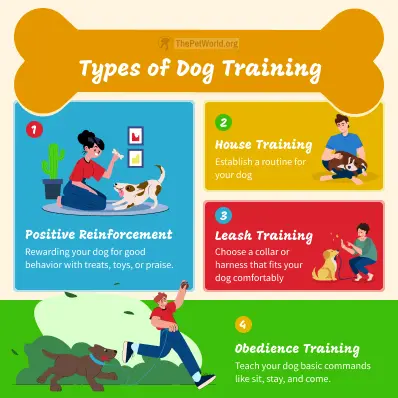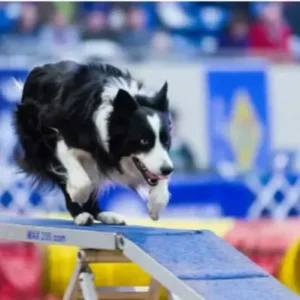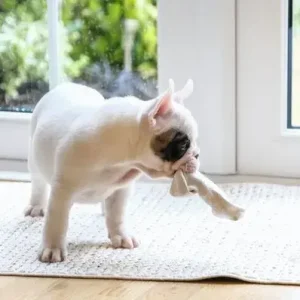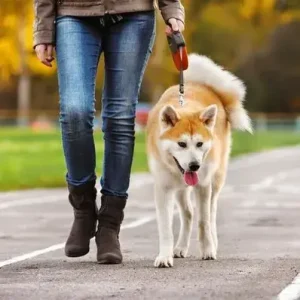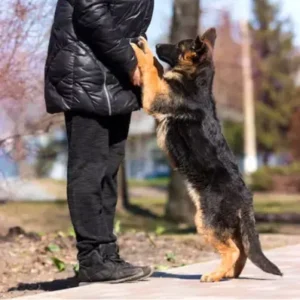Types of Dog Training
Now that you have some of the top dog training tips, you can learn about different types of training:
Positive Reinforcement
Positive reinforcement is a powerful tool for training your dog. It involves rewarding your dog for good behavior with treats, toys, or praise.
This encourages your dog to repeat the behavior in the future. For example, if you want to teach your dog to come when called, start by calling its name and rewarding it with a treat when it comes to you. Over time, your dog will learn that coming when called is a good thing. Similarly, consistent rewards for proper behavior, such as going outside to potty, are essential when learning how to potty train a puppy.
House Training
House training is an important part of dog training. To get started, establish a routine for your dog that includes regular feeding times and potty breaks.
When your dog goes potty outside, reward it with a treat and praise. If your dog has an accident inside, clean it up immediately and avoid punishing your dog. Instead, focus on establishing a consistent routine and rewarding good behavior.
Leash Training
Leash training is another important aspect of dog training. To get started, choose a collar or harness that fits your dog comfortably.
Introduce your dog to the collar or harness gradually, and reward it with treats and praise. Once your dog is comfortable wearing the collar or harness, attach a leash and let your dog drag it around the house. Over time, your dog will learn to associate the leash with going for a walk.
Obedience Training
Obedience training is a great way to establish a strong bond with your furry friend. It’s all about teaching your dog basic commands like sit, stay, and come.
You can use treats and praise to reward your dog for following your commands. Keep the training sessions short and frequent to keep your dog interested. As your dog becomes more skilled at basic commands, you can gradually introduce more advanced training techniques.
Clicker Training
Clicker training simplifies communication with your dog. Use a clicker to make a distinct sound when your dog nails a command, immediately followed by a treat.
This clear association helps them understand and replicate desired behaviors, making it ideal for teaching tricks and refining their skills.
Agility Training
For a dynamic and engaging training experience, try agility training. Guide your dog through obstacles like tunnels, jumps, and weave poles.
This not only keeps them physically active but also sharpens their problem-solving abilities. Start with basic challenges and gradually increase difficulty, turning training sessions into a playful adventure for both you and your furry friend.
Crate Training
Crate training involves teaching your dog to feel comfortable in a crate, which can serve as a safe and cozy space for them. You can introduce the crate gradually, using positive experiences like treats and toys to help your dog associate the crate with good things.
Start with short periods of time in the crate, gradually increasing the duration as your dog becomes more comfortable. Crate training can be useful for traveling and vet visits, providing your dog with a sense of designated space to call their own.
Socialization
Socialization is crucial for your dog’s development. It involves exposing your dog to new people, animals, and environments in a positive way.
To get started, take your dog to a dog park or other public place where it can interact with other dogs and people. Reward your dog with treats and praise for good behavior. Over time, your dog will learn to be comfortable in new situations.
Tips And Tricks For Training Your Dog Effectively
Training your dog is not just about teaching commands; it’s about creating a positive and enjoyable learning experience for both of you. Here are some practical dog training tips for beginners to make your training sessions more effective and fun:
Tip#1 – Show Them Instead of Telling
Dogs learn more by watching than just by instructions. Including actions and hand signals can go a long way in your dog’s learning.
So, when training your dog to sit, instead of just saying “sit,” demonstrate the action. Repeating yourself saying the word ‘sit’ won’t help, instead showing them would.
If you’re teaching them to fetch, throw the ball a few times to show what you expect. Dogs pick up on these visual cues and understand faster.
Tip#2 – Take It Easy
Keep things light and fun. Short, focused sessions work wonders.
Imagine being in a class where the teacher drones on – boring, right? Dogs feel the same. A few minutes of energetic training will keep them engaged and excited to learn.
Tip#3 – Reward Them With Treats
Positive reinforcement is a powerful tool for training your dog. Reward your dog with training treats when they exhibit good behavior.
When they follow a command correctly, immediately reward them with a tasty treat. It reinforces the idea that doing what you ask brings good things. Pay attention to the treats they respond to the best and choose accordingly, and remember, moderation is key!
Tip#4 – Adjust to their Age and Comprehension Level
Dogs of different ages and breeds have different learning abilities. Adjust your training techniques to suit your dog’s age and comprehension level.
Puppy training may take longer and need simpler commands, while older dogs can handle more complexity. Adjust your expectations and pace to match their capabilities.
Tip#5 – Understand Their Body Language and Response
Dogs talk, not in words, but through body language. To really understand their responses, observe their body language and vocalizations.
Watch their tail, ears, and overall demeanor. If they look confused, simplify. If they’re excited, you’re on the right track. Being attentive to their cues helps you adjust your approach and keep training positive.
Tip#6 – Praise Them Often
Dogs and puppies thrive on positive feedback. Shower them with genuine praise when they do well. Use an enthusiastic tone, pet them, and let them know they’re the best dog ever.
Unexpected praise and hugs go a long way in making training a joyful experience for your furry friend.
Tip#7 – Be Consistent
Imagine if red meant “stop” today and “go” tomorrow. It’d be confusing, right?
Dogs feel the same about inconsistent commands. Stick to the same cues and rewards, so your dog can easily connect the dots and understand what you want.
Tip#8 – Use Different Training Environments
Dogs are smart, but they need to generalize commands.
Start training them in various spots – inside, outside, at the park. This helps them grasp that “sit” means the same thing everywhere. It’s like teaching a universal language of good behavior!
Tip#9 – Mix in Fun Activities
Learning is more exciting when mixed with play. Toss a toy, run around a bit, or play a quick game of tug-of-war during breaks. This not only keeps them physically active but also mentally stimulated. Happy training equals a happy dog!
Tip#10 – Stay Calm and Positive
Dogs pick up on your vibes and attitude way quicker than you think. Don’t expect your dog to have mastered command in one go. Give it time and multiple tries.
If you’re frustrated or upset, they’ll sense it. Stay calm, be patient, and maintain a positive attitude. Your encouragement and happiness will motivate them to learn and make training a positive experience for both of you.

